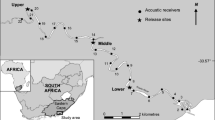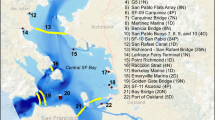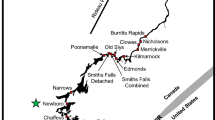Abstract
Acoustic telemetry was employed to resolve seasonal and daily movement patterns of adult red drum (Sciaenops ocellatus) in the northern Indian River Lagoon system, Florida. From May 2006 to September 2008, 44 tagged fish were tracked within an array of 34 autonomous receivers with individuals detected for up to 654 days. Most red drum exhibited strong site fidelity from winter through early summer with movement rates increasing significantly during fall spawning months. While some fish migrated to the nearest ocean inlet at this time, the majority remained within the lagoon year-round suggesting that true estuarine reproduction, a behavior uncommon or poorly documented elsewhere is the dominant life history strategy locally. Diel movement patterns were also pronounced and indicated changing depth preferences over a 24 h period. Despite a harvest prohibition on large red drum, long-term estuarine residency coupled with high angling pressure (41% recapture rate in 50 months) suggest that post-release angling mortality and sub-lethal effects to growth and reproduction may strongly influence the strength of adult size classes.







Similar content being viewed by others
References
Aguilar R (2003) Short-term hooking mortality and movement of adult red drum (Sciaenops ocellatus) in the Neuse River, North Carolina. MS Thesis, North Carolina State University, Raleigh, 126 p
Atlantic States Marine Fisheries Commission (2002) Fishery management report No. 38 of the Atlantic States Marine Fisheries Commission: Amendment 2 to the interstate fishery management plan for red drum, 142 p
Bacheler NM, Paramore LM, Buckel JA, Scharf FS (2008) Recruitment of juvenile red drum in North Carolina: spatiotemporal patterns of year-class strength and validation of a seine survey. N Am J Fish Manage 28:1086–1098
Barrios AT (2004) Use of passive acoustic monitoring to resolve spatial and temporal patterns of spawning activity for red drum, Sciaenops ocellatus, in the Neuse River Estuary, North Carolina. MS Thesis, North Carolina State University, Raleigh, 97 p
Beckman DW, Wilson CA, Stanley AL (1988) Age and growth of red drum, Sciaenops ocellatus, from offshore waters of the Gulf of Mexico. Fish Bull 87:17–28
Cardeilhac PT, Simpson CF, White FH, Thompson NP, Carr WE (1981) Evidence for metal poisoning in acute deaths of large red drum (Sciaenops ocellata). Bull Environm Contam Toxicol 27:639–644
Carr W, Smith JR (1977) A study of the spawning movements and a tentative spawning site of the red drum, Sciaenops ocellata. Final report to the Florida Sea Grant Program. University of Florida, Gainesville, p 31
Chapman RW, Ball AO, Mash LR (2002) Spatial homogeneity and temporal heterogeneity of red drum (Sciaenops ocellatus) microsatellites: effective population sizes and management implications. Mar Biotechnol 4:589–603
Collins MR, Callahan BM, Post WC (2001) Spawning aggregations of recreationally important sciaenid species in the Savannah Harbor: spotted seatrout Cynoscion nebulosus, red drum Sciaenops ocellatus, weakfish Cynoscion regalis, and black drum Pogonias cromis. Final report to Georgia Ports Authority by the South Carolina Department of Natural Resources Marine Resources Research Institute, September 21, 2001
Comyns BH, Lyczkowski-Schultz J, Nieland DL, Wilson CA (1991) Reproduction of red drum, Sciaenops ocellatus, in the northcentral Gulf of Mexico: seasonality and spawning biomass. NOAA Tech Rep NMFS 95:17–26
Cowan JH Jr, Birdsong RS, Houde ED, Priest JS, Sharp WC, Mateja GB (1992) Enclosure experiments on survival and growth of black drum eggs and larvae in lower Chesapeake Bay. Estuaries 15:392–402
Gilmore RG Jr (1995) Environmental and biogeographic factors influencing ichthyofaunal diversity in the Indian River Lagoon. B Mar Sci 57:153–170
Heupel MR, Hueter RE (2001) Use of an automated acoustic telemetry system to passively track juvenile blacktip shark movements. In: Sibert JR, Nielsen JL (eds) Electronic tagging and tracking in marine fisheries. Kluwer, Netherlands, pp 217–236
Heupel MR, Reiss KL, Yeiser BG, Simpfendorfer CA (2008) Effects of biofouling on performance of moored data logging acoustic receivers. Limnol Oceanogr Meth 6:327–335
Holloway-Adkins KG, Scheidt DM, Reyier EA, Lowers RH, Epstein MB (2005) Resource use characterization of Mosquito Lagoon within the boundaries of Merritt Island National Wildlife Refuge: results from the 2002–2003 exit ramp, creel, and aerial surveys. Final report to Merritt Island National Wildlife Refuge, 171 p
Holt SA (2008) Distribution of red drum spawning sites identified by a towed hydrophone array. Trans Am Fish Soc 137:551–561
Holt J, Godbout R, Arnold CR (1981) Effects of temperature and salinity on egg hatching and larval survival of red drum, Sciaenops ocellata. Fish Bull 79:569–573
Holt GJ, Holt SA, Arnold CR (1985) Diel periodicity of spawning in sciaenids. Mar Ecol Prog Ser 27:1–7
Johnson DR, Funicelli NA (1991) Spawning of the red drum in Mosquito Lagoon, east-central Florida. Estuaries 14:74–79
Lowerre-Barbieri SK, Barbieri LR, Flanders JR, Woodward AG, Cotton CF, Knowlton MK (2008) Use of passive acoustics to determine red drum spawning in Georgia waters. Tans Am Fish Soc 137:562–575
Luczkovich JJ, Daniel HJ III, Sprague MW (1999) Characterization of critical spawning habitats of weakfish, spotted seatrout and red drum in Pamlico Sound using hydrophone surveys. North Carolina Department of Environment and Natural Resources Division of Marine Fisheries Final Report and Annual Performance Report Completion Report Grant F-62-1 and F-62-2, 128 p
Marks RE Jr, DiDomenico GP (1996) Tagging studies, maturity, and spawning seasonality of red drum (Sciaenops ocellatus) in North Carolina. North Carolina Division of Marine Fisheries, Completion Report Grant F-43, 39 p
Mercer LP (1984) A biological and fisheries profile of red drum, Sciaenops ocellatus. North Carolina Department of Natural Resources and Community Development. Division of Marine Fisheries Special Scientific Report No. 41, 89 p
Murphy MD, Crabtree RE (2001) Changes in the age structure of nearshore adult red drum off west-central Florida related to recruitment and fishing mortality. N Am J Fish Manage 21:671–678
Murphy MD, Munyandorero J (2009) An assessment of the status of red drum in Florida waters through 2007. Florida Fish and Wildlife Conservation Commission—Fish and Wildlife Research Institute In-House Report 2008-008, 106 p
Murphy MD, Taylor RG (1990) Reproduction, growth, and mortality of red drum, Sciaenops ocellatus, in Florida waters. Fish Bull 88:531–542
Nicholson N, Jordan SR (1994) Biotelemetry study of red drum in Georgia: November 1989–June 1993. Georgia Department of Natural Resources, Brunswick, p 64
Osburn HR, Matlock GC, Green AW (1982) Red drum (Sciaenops ocellatus) movements in Texas bays. Contrib Mar Sci 25:85–97
Overstreet RM (1983) Aspects of the biology of the red drum, Sciaenops ocellatus, in Mississippi. Gulf Res Rep Suppl 1:45–68
Pafford JM, Woodward AG, Nicholson N (1990) Mortality, movement and growth of red drum in Georgia. Final report. Georgia Department of Natural Resources, Brunswick, p 85
Peters KM, McMichael RH Jr (1987) Early life history of the red drum, Sciaenops ocellatus (Pisces: Sciaenidae) in Tampa Bay, Florida. Estuaries 10:92–107
Provancha MJ, Schmalzer PA, Hall CR (1986) Effects of the December 1983 and January 1985 freezing air temperatures on select aquatic poikilotherms and plant species of Merritt Island, Florida. Fla Sci 49:193–198
Reyier EA, Shenker JM (2007) Ichthyoplankton community structure in a shallow subtropical estuary of the Florida Atlantic coast. B Mar Sci 80:267–293
Rooker JR, Holt SA, Soto MA, Holt GJ (1998) Postsettlement patterns of habitat use by sciaenid fishes in subtropical seagrass meadows. Estuaries 21:318–327
Ross JL, Stevens TM (1992) Life history and population dynamics of red drum (Sciaenops ocellatus) in North Carolina waters. North Carolina Division of Marine Fisheries, Completion Report Grant Project F-29, 130 p
Ross JL, Stevens TM, Vaughan DS (1995) Age, growth, mortality, and reproductive biology of red drum in North Carolina waters. Trans Am Fish Soc 124:37–54
Seyoum S, Tringali MD, Bert TM, McElroy DM, Stokes R (2000) An analysis of genetic population structure in red drum, Sciaenops ocellatus, based on mtDNA control region sequences. Fish Bull 98:127–138
Simmons EG, Breuer JP (1962) A study of redfish, Sciaenops ocellata Linnaeus and black drum, Pogonias cromis Linnaeus. Contrib Mar Sci 8:184–211
Smith NP (1987) An introduction to the tides of Florida’s Indian River Lagoon. I. water levels. Fla Sci 50:49–61
Snelson FF Jr (1983) Ichthyofauna of the northern part of the Indian River Lagoon system, Florida. Fla Sci 46:187–206
Snelson FF Jr, Bradley WK (1978) Mortality of fishes due to cold on the east coast of Florida, January, 1977. Fla Sci 41:1–12
Sokal RR, Rohlf FJ (1995) Biometry. W.H. Freeman, New York
Steidinger KA, Landsberg JH, Truby EW, Roberts BS (1998) First report of Gymnodinium pulchellum (Dinophceae) in North America and associated fish kills in the Indian River, Florida. J Phycol 34:431–437
Stevens PW, Sulak KJ (2001) Egress of adult sport fish from an estuarine reserve within Merritt Island National Wildlife Refuge, Florida. Gulf Mex Sci 2:77–89
Stunz GW, Minello TJ, Levin PS (2002) A comparison of early juvenile red drum densities among various habitat types in Galveston Bay, Texas. Estuaries 25:76–85
Takade H, Paramore L (2007) Stock status of the northern red drum stock. North Carolina Division of Marine Fisheries. In-House Report, 60 p
Thronson A, Quigg A (2008) Fifty-five years of fish kills in coastal Texas. Estuaries Coasts 31:802–813
Tremain DM, Harnden CW, Adams DH (2004) Multidirectional movements of sportfish species between an estuarine no-take zone and surrounding waters of the Indian River Lagoon, Florida. Fish Bull 102:533–544
Vaughan DS, Carmichael JT (2000) Assessment of Atlantic red drum for 1999: northern and southern regions. NOAA Technical Memorandum NMFS-SWFSC-447, 54 p. + app
Vecchio JL, Wenner CA (2007) Catch-and-release mortality in subadult and adult red drum captured with popular fishing hook types. N Am J Fish Manage 27:891–899
Wilson CA, Nieland DL (1994) Reproductive biology of red drum, Sciaenops ocellatus, from the neritic waters of the northern Gulf of Mexico. Fish Bull 92:841–850
Woodward AG (1994) Tagging studies and population dynamics of red drum in coastal Georgia. Final Report. Georgia Department of Natural Resources, Brunswick, p 71
Woodward-Clyde (1994) Physical features of the Indian River Lagoon. Indian River Lagoon National Estuary Program, Melbourne Florida. Final Tech. Rep. Project No. 92F274C. Tampa, Florida, 166 p
Acknowledgements
We wish to express our gratitude to Carla Garreau, Shanon Gann, Karen Holloway-Adkins, and Mark Provancha (Innovative Health Applications), D. Scott Taylor (Brevard County), and Captain Jim Ross for their aid in fish collections and equipment maintenance. We thank Billy Payne (Matrix Corporation) and especially Dan Hunt (Innovative Health Applications) for invaluable assistance with data management, and Carlton Hall (Innovative Health Applications), George Burgess (University of Florida), and the staff of Merritt Island National Wildlife Refuge and Canaveral National Seashore for logistical support. We also thank Josh Taylor and John Hadden (Florida Fish & Wildlife Conservation Commission) for help with angler tag return data. Lauren Hall at St. John’s River Water Management District graciously provided valuable water quality data. Funding for this research was provided through the NASA Life Sciences Service Contract as well as the Disney Wildlife Conservation Fund (UF-07-04) and Florida Non-Game Wildlife Grant (NG06-019) awarded to the University of Florida.
Author information
Authors and Affiliations
Corresponding author
Rights and permissions
About this article
Cite this article
Reyier, E.A., Lowers, R.H., Scheidt, D.M. et al. Movement patterns of adult red drum, Sciaenops ocellatus, in shallow Florida lagoons as inferred through autonomous acoustic telemetry. Environ Biol Fish 90, 343–360 (2011). https://doi.org/10.1007/s10641-010-9745-3
Received:
Accepted:
Published:
Issue Date:
DOI: https://doi.org/10.1007/s10641-010-9745-3




